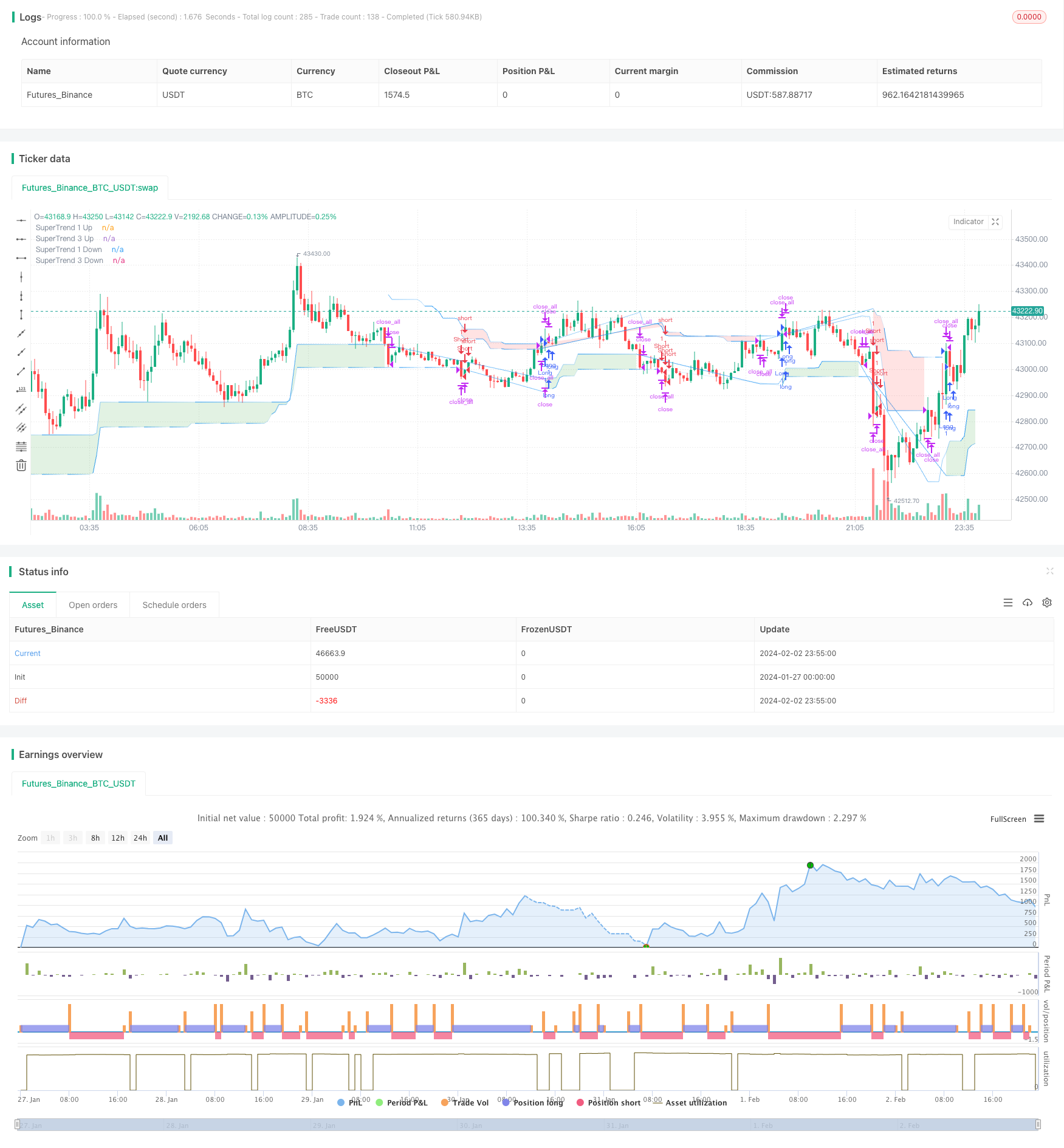쿼드라틱 모멘텀 이중 지표 타이밍 전략
저자:차오장, 날짜: 2024-02-04 15:53:48태그:

전반적인 설명
이 전략은 슈퍼 트렌드 지표와 엘리엇 웨브 이론을 결합하여 강력한 기술적 거래 도구를 구축합니다. 이는 잠재적인 트렌드 역전 및 중요한 가격 움직임을 조기에 파악 할 수있는 보다 포괄적인 시장 관점을 제공하기 위해 다단계 트렌드 분석을 사용합니다.
전략 원칙
핵심 아이디어는 여러 단계의 접근 방식에 있습니다.
- 4 개의 슈퍼 트렌드 지표를 사용하십시오. 각각 다른 ATR 길이와 곱셈자를 사용하여 단기에서 장기간에 걸쳐 트렌드를 판단하십시오.
- 지표 컨버전스를 통해 강력한 긴 신호와 짧은 신호를 파악합니다.
- 거래 신호를 확인하기 위해 유사한 시장 행동을 식별하기 위해 Elliott Wave의 패턴 인식 방법을 참조하십시오.
따라서 여러 지표를 활용하고 패턴 인식 기능을 추가하여 전략을 더욱 견고하게 만듭니다.
이점 분석
- 다중 지표 설계는 포괄적 인 판단을 제공합니다.
- 파동 이론의 영감을 통해 패턴 인식의 안정성을 높입니다.
- 실시간 방향 조정 시장 변화에 적응
- 구성 가능한 매개 변수는 다른 제품과 시간 프레임에 적합합니다.
위험 분석
- 매개 변수 설정은 경험에 의존하며 최적의 매개 변수 조합을 결정하기 위해 조정이 필요합니다.
- 다중 지표 설계는 복잡하고 계산 부하가 증가합니다.
- 잘못된 신호 발생을 완전히 피할 수 없습니다
매개 변수들은 최적을 점진적으로 결정하기 위해 최적화 될 수 있습니다. 클라우드 컴퓨팅은 컴퓨팅 성능을 향상시킬 수 있습니다.
최적화 방향
최적화는 몇 가지 측면에서 이루어질 수 있습니다.
- 시장 조건에 따라 동적으로 매개 변수를 조정하는 적응 매개 변수 조정 모듈을 추가
- 신호 신뢰성을 판단하는 데 도움이되는 기계 학습 모델을 통합합니다.
- 감정 지표, 뉴스 이벤트 등을 결합하여 시장 체제를 결정합니다.
- 테스트 작업 부하를 줄이기 위해 여러 제품 매개 변수 템플릿을 지원
이것은 전략 매개 변수를 더 지능화하고 판단을 더 정확하고 실제 적용을 더 편리하게 할 것입니다.
요약
이 전략은 유연성을 높이는 동시에 판단의 견고성을 보장하는 경향과 패턴 차원을 포괄적으로 고려합니다. 다중 지표 및 매개 변수 설정은 시장의 완전한 적용성을 보장합니다. 지능적이고 자동화된 방법을 추가로 통합하면 전략 실용성이 크게 향상 될 수 있습니다. 기술 거래의 발전에 귀중한 영감을 제공하고 참조를 제공합니다.
/*backtest
start: 2024-01-27 00:00:00
end: 2024-02-03 00:00:00
period: 5m
basePeriod: 1m
exchanges: [{"eid":"Futures_Binance","currency":"BTC_USDT"}]
*/
//@version=5
strategy("Elliott's Quadratic Momentum - Strategy [presentTrading]",shorttitle = "EQM Strategy [presentTrading]", overlay=true )
// Inputs for selecting trading direction
tradingDirection = input.string("Both", "Select Trading Direction", options=["Long", "Short", "Both"])
// SuperTrend Function
supertrend(src, atrLength, multiplier) =>
atr = ta.atr(atrLength)
up = hl2 - (multiplier * atr)
dn = hl2 + (multiplier * atr)
trend = 1
trend := nz(trend[1], 1)
up := src > nz(up[1], 0) and src[1] > nz(up[1], 0) ? math.max(up, nz(up[1], 0)) : up
dn := src < nz(dn[1], 0) and src[1] < nz(dn[1], 0) ? math.min(dn, nz(dn[1], 0)) : dn
trend := src > nz(dn[1], 0) ? 1 : src < nz(up[1], 0)? -1 : nz(trend[1], 1)
[up, dn, trend]
// Inputs for SuperTrend settings
atrLength1 = input(7, title="ATR Length for SuperTrend 1")
multiplier1 = input(4.0, title="Multiplier for SuperTrend 1")
atrLength2 = input(14, title="ATR Length for SuperTrend 2")
multiplier2 = input(3.618, title="Multiplier for SuperTrend 2")
atrLength3 = input(21, title="ATR Length for SuperTrend 3")
multiplier3 = input(3.5, title="Multiplier for SuperTrend 3")
atrLength4 = input(28, title="ATR Length for SuperTrend 3")
multiplier4 = input(3.382, title="Multiplier for SuperTrend 3")
// Calculate SuperTrend
[up1, dn1, trend1] = supertrend(close, atrLength1, multiplier1)
[up2, dn2, trend2] = supertrend(close, atrLength2, multiplier2)
[up3, dn3, trend3] = supertrend(close, atrLength3, multiplier3)
[up4, dn4, trend4] = supertrend(close, atrLength4, multiplier4)
// Entry Conditions based on SuperTrend and Elliott Wave-like patterns
longCondition = trend1 == 1 and trend2 == 1 and trend3 == 1 and trend4 == 1
shortCondition = trend1 == -1 and trend2 == -1 and trend3 == -1 and trend4 == - 1
// Strategy Entry logic based on selected trading direction
if tradingDirection == "Long" or tradingDirection == "Both"
if longCondition
strategy.entry("Long", strategy.long)
// [Any additional logic for long entry]
if tradingDirection == "Short" or tradingDirection == "Both"
if shortCondition
strategy.entry("Short", strategy.short)
// [Any additional logic for short entry]
// Exit conditions - Define your own exit strategy
// Example: Exit when any SuperTrend flips
if trend1 != trend1[1] or trend2 != trend2[1] or trend3 != trend3[1] or trend4 != trend4[1]
strategy.close_all()
// Function to apply gradient effect
gradientColor(baseColor, length, currentBar) =>
var color res = color.new(baseColor, 100)
if currentBar <= length
res := color.new(baseColor, int(100 * currentBar / length))
res
// Apply gradient effect
color1 = gradientColor(color.blue, atrLength1, bar_index % atrLength1)
color4 = gradientColor(color.blue, atrLength4, bar_index % atrLength3)
// Plot SuperTrend with gradient for upward trend
plot1Up = plot(trend1 == 1 ? up1 : na, color=color1, linewidth=1, title="SuperTrend 1 Up")
plot4Up = plot(trend4 == 1 ? up4 : na, color=color4, linewidth=1, title="SuperTrend 3 Up")
// Plot SuperTrend with gradient for downward trend
plot1Down = plot(trend1 == -1 ? dn1 : na, color=color1, linewidth=1, title="SuperTrend 1 Down")
plot4Down = plot(trend4 == -1 ? dn4 : na, color=color4, linewidth=1, title="SuperTrend 3 Down")
// Filling the area between the first and third SuperTrend lines for upward trend
fill(plot1Up, plot4Up, color=color.new(color.green, 80), title="SuperTrend Upward Band")
// Filling the area between the first and third SuperTrend lines for downward trend
fill(plot1Down, plot4Down, color=color.new(color.red, 80), title="SuperTrend Downward Band")
더 많은
- 윌리 원카의 탈출 전략
- 기하급수적 이동 평균 및 상대적 강도 지수 조합 추세 전략에 따라
- 역전 트렌드 포착 및 동적 스톱 손실 컴보 전략
- 골든 패러볼라 브레이크업 전략
- SAR 모멘텀 역전 추적 전략
- 동적 RSI 거래 전략
- 다중 이동 평균의 크로스오버 전략
- 이중 이동평균 파업 전략
- 이동 평균 크로스오버 전략
- 이중 이동 평균 트렌드 추적 전략
- 렌코와 상대적 활력 지수 트렌드 전략
- 스윙 트렌드 이동 평균 전략
- 볼링거 밴드, 이동 평균 및 MACD 결합 거래 전략
- 동력 가격 상승 암호화폐 전략
- 멀티 팩터 모델에 기반한 모멘텀 트레이딩 전략
- 적응형 볼링거 밴드 트렌드 추적 전략
- 손실 중지 및 수익을 취하는 향상된 RSI 브레이크업 전략
- RSI 및 볼린거 대역에 기초한 양적 거래 전략
- SMA와 롤링 트렌드 라인을 기반으로 한 양적 거래 전략
- 주간 옵션 거래 전략